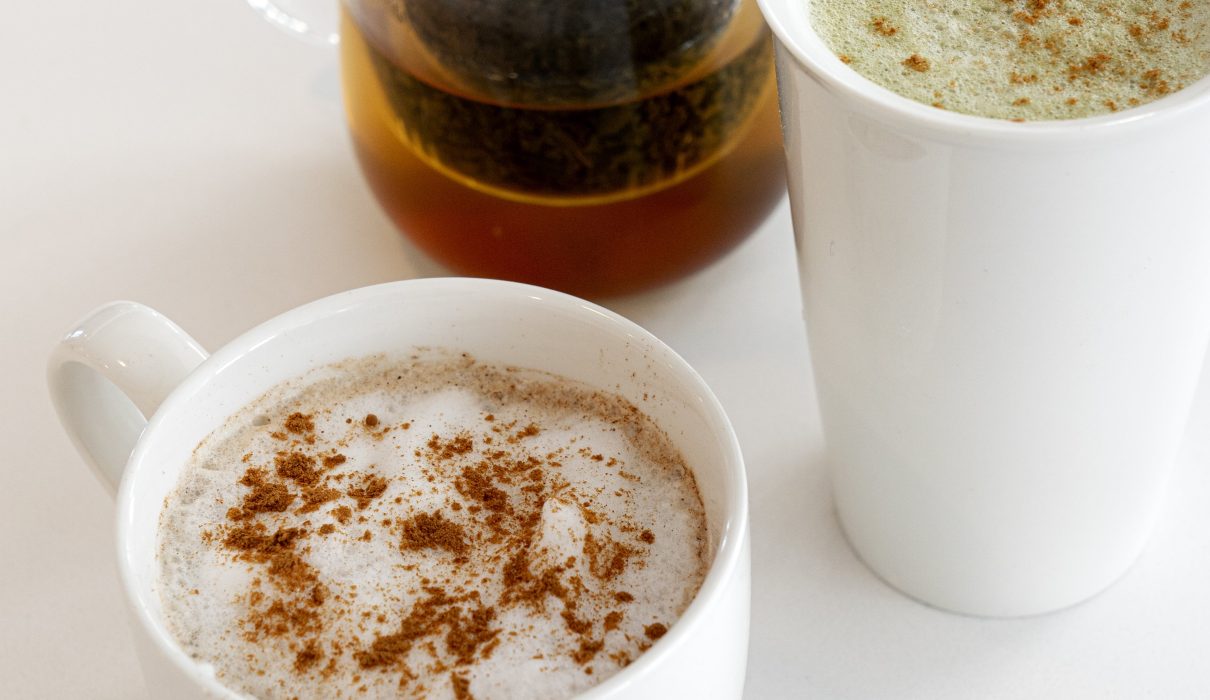Photos by L.G. Patterson
At 15, I started my first real culinary job working for Starbucks in Sonoma County, California. Over the next three years, I worked at several locations around my hometown until I went off to San Francisco for culinary school.
I loved working at Starbucks! All the delicious drinks, holiday specials, kind caffeinated customers and the fastpaced environment made it perfect for me. I love the coziness in coffee shops that allows for people to gather and discuss life, work on projects or just to sit and enjoy their cup of joe.
Columbia has one of the best local coffee shop communities I have ever had the pleasure to experience. From Lakota to Fretboard to The Grind or even Nourish, you can find the atmosphere, and favorite beverages, for you.
At Nourish, we have been using Z Best’s coffee grounds for our drip coffee, and Fret
board espresso beans for years. I even created espresso truffles using Fretboard espresso grounds. For our hot or iced teas, we use Big Heart Tea out of St. Louis. We even use paste from Raw Roots Turmeric, a local company, for our turmeric lattes. We love supporting local and you know they provide the highest quality ingredients.
So what is the difference between coffee, espresso and matcha tea? Caffeine obviously plays a large part.
Matcha does contain caffeine — around 30 milligrams in half a teaspoon, which is the serving size recommended on most matcha green tea packages. In comparison, according to the USDA, a shot of espresso contains 63.6 milligrams of caffeine, while eight fluid ounces of brewed coffee has 95 milligrams.
Coffee provides high levels of antioxidants, such as polyphenols, which can help defend against free radical damage that contributes to disease formation and signs of aging. Studies show that polyphenols and other compounds in coffee have antioxidant, anti-inflammatory, anti-cancer, anti-diabetes and antihypertensive properties.
Green tea, black tea, matcha tea and mushroom coffee are great alternatives to coffee and espresso. Green and black tea both contain caffeine. Green tea contains less caffeine than black tea — about 35 milligrams of caffeine per eight-ounce cup for green tea, compared to 39-109 milligrams for the same serving of black tea.
Matcha is not your typical green tea — it’s a concentrated Japanese tea that works as an effective detoxifier, fat burner and health promoter.
Green tea is the No. 1 anti-aging drink because it’s packed with flavonoid, polyphenol and catechin antioxidants. Drinking green tea regularly promotes better health and longevity because it works to reduce inflammation and oxidative stress that leads to so many health issues. Research shows that the benefits of green tea include its ability to boost heart health by lowering blood pressure and cholesterol levels, prevent memory loss and brain cell damage, prevent insulin resistance, promote bone health and protect your vision
Mushroom coffee is just that — coffee mixed with pure mushroom extract. It doesn’t taste like fungi, though. Instead, this beverage exudes the rich coffee flavor that makes up most of the drink.
Early mushroom coffee was made by soaking the chaga mushroom in water overnight and pressing out the liquid. That could be boiled alone or mixed with bits of real coffee for flavor.
Modern mushroom coffee uses extract from fungi, including the already mentioned chaga, reishi, lion’s mane and cordyceps mushrooms. Lion’s mane is consumed to help with brain function and ulcers, while reishi mushrooms may lower blood pressure and reduce stress. The cordyceps fungus
is supposed to help regulate blood sugar and give energy, but not nervous energy like the caffeine in coffee can induce. The original mushroom, chaga, has been known to support the immune system by stimulating white blood cells and aiding antibody growth.
Since my experience working for Starbucks, I have learned that not all lattes, teas or coffees are created equal. Most latte syrups are filled withsugars and preservatives that are harmful when you over-consume. This is why I have created my own recipes for things like chai latte syrup.
I also always make my own nut or seed milks for my lattes with my almond cow or a Vitamix blender. Milks in traditional coffee shops have preservatives, sugars or other toxic ingredients. If you do drink dairy milks in your beverages, I suggest using local high-quality milks like those from Ozark Mountain Creamery. I have made healthy lattes with matcha, homemade chai syrup, adaptogens and local turmeric paste, as well as mochas with raw cacao powder and maple syrup.
No matter what gets you out of bed in the morning, make sure you are using the best ingredients for your body!
Kimber Dean is the founder of Happiness Drinks, and the author of Happy Food and Happy Baking and Desserts. She is trained
in both culinary arts and personal nutrition.
Vegan Chai Latte Syrup
Ingredients
- 6 tea bags caffeinated or decaffeinated
- 3/4 cup water, hot
- 1/2 cup MCT oil
- 1/2 cup maple syrup
Instructions
- Steep tea bags in hot water for 10-20 minutes, depending on your preferred strength. Discard bags when finished.
- Mix hot brewed tea and maple syrup in a high-powered blender. Slowly drizzle in the MCT oil to emulsify.
- Store in an airtight container in the refrigerator.
Chai Latte
Ingredients
- 14 ounces vanilla almond milk
- 1 1/2 ounces chai syrup (3 teaspoons)
- 1 1/2 teaspoons chai spice
- sprinkle of cinnamon
Instructions
- Steam almond milk to 165 degrees with a tight foam. When the milk is done steaming, place chai syrup and spices into a mug.
- Pour steamed milk into the cup with syrup and spices, and blend until dissolved. Sprinkle with cinnamon. Serve hot and enjoy!



